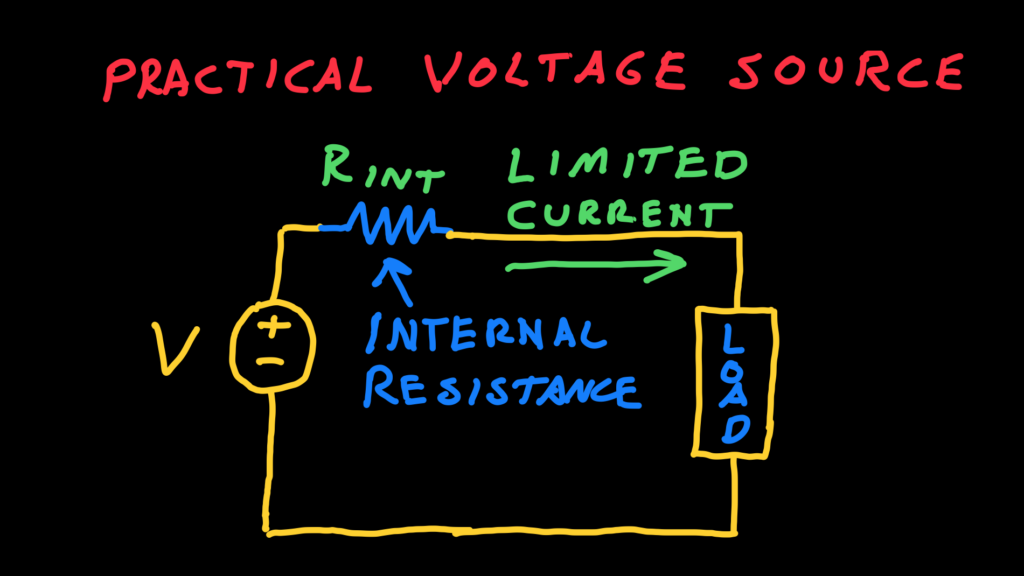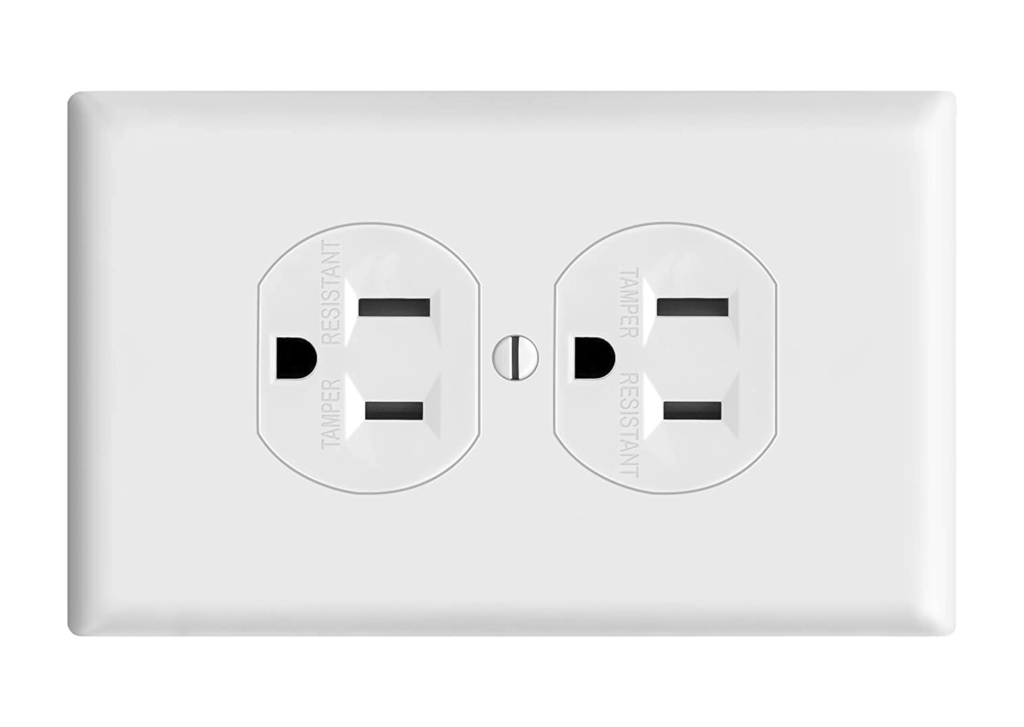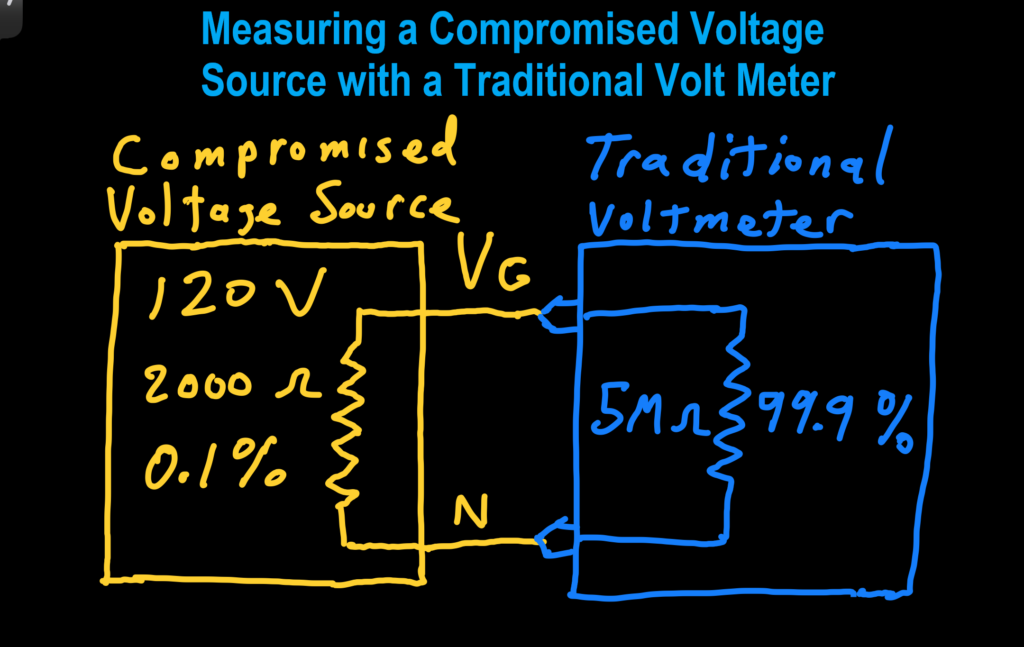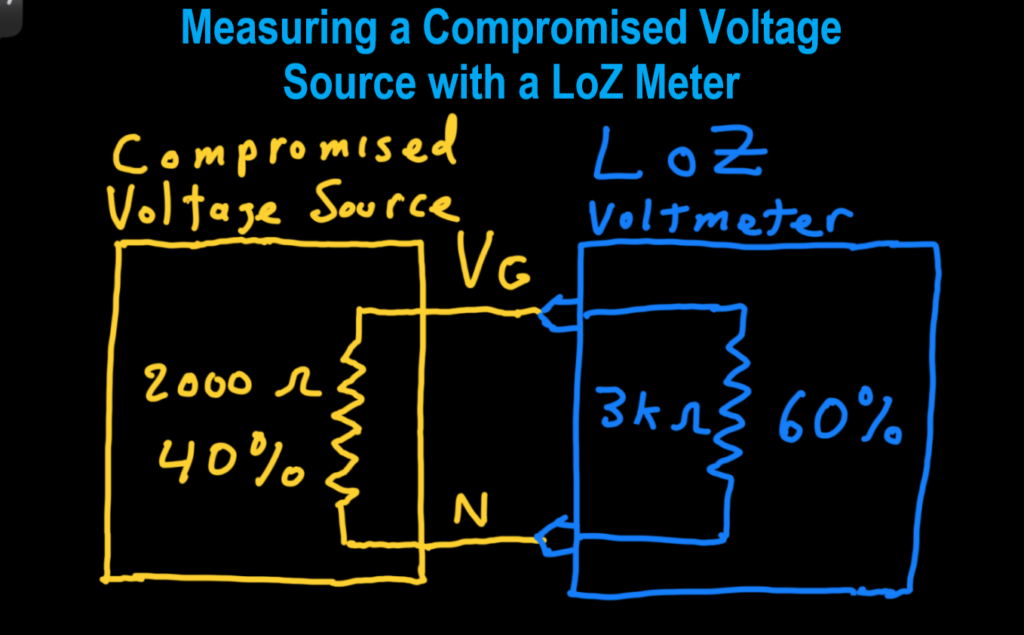Introduction
Wouldn’t it be great to have a battery that could supply an infinite current? Your flashlight could run on AA batteries, yet have infinite brightness! You could start a car with a standard 9v battery! Such batteries would be “ideal” voltage sources. Now, enter reality.

What is a Voltage Source?
A voltage source is a two terminal device that is designed to maintain a fixed voltage. An ideal voltage source can supply an infinite amount of current without any drop in voltage. Such a device doesn’t exist in the practical world – but the output impedance or resistance of such a device dictates how much current it can supply without an unacceptable drop in output voltage.
Output Impedance
The single most important factor that affects how “strong” a voltage source is its output impedance. For DC sources such as batteries, this also referred to as “internal resistance”. What is that though? All voltage sources (120v outlets, car batteries, 9V batteries) have an output impedance or resistance (depending if it is an AC or DC source). We won’t get into impedance in this article, but to keep it simple, it is the opposition to current flow, like resistance is, but in the AC realm. So for AC, we’ll call it impedance, and for DC, we’ll call it resistance.

Strong Voltage Source
Two examples of relatively strong voltage sources are a car battery and a 120v residential outlet.
12V Lead Acid Car Battery
The car battery can supply hundreds of amps, without an unacceptable drop in voltage. In order for it to do this, it would need to have an extremely low internal (or output resistance). Suppose the car battery supplied 100 amps and only dropped by 2 volts to 10 volts. Thus, the internal (or output) resistance is R = V/I = (2 volt drop)(100 amps) = .02 ohms.

120v Residential Outlet
The 120v residential outlet is the other mentioned “strong” voltage source. These types of outlets have an output impedance of around 0.5 ohms. Thus is you were to draw 10 amps from it, like from a hair dryer, you might see a V = I x R = (10 amps) x (0.5 ohms) = 5 volt drop, at the outlet.

Weak Voltage Source – 9V Battery
An example of a relatively weak voltage source, is the aforementioned 9V battery. These batteries have an internal resistance (or output resistance) of around 5 ohms. This means that if you try and draw an amp from it, there would be a V = I x R = (1 amp) x (5 ohms) = 5 volt drop across that internal resistance, leaving only 4 volts for the load. Now it is easy to see why you can’t start a car with a 9V battery. The sheer current draw across that 5 ohms of internal resistance, would cause the full 9 volts to be lost across that resistance.

Functional Voltage Sources
Functional Voltage sources are working as intended because their output resistance or impedance is within the designed range.
Compromised Voltage Source
Now we segue way into the compromised voltage source. Generally, when something is compromised, it isn’t working to it’s full or intended potential. There can be very strong, strong, and weak voltage sources, but if they are working as designed, we know what to expect, know what their target applications should be, and the world lives to see another day. What if that voltage source fails though, and can’t supply its intended amount of current? That is a compromised voltage source. Here are some examples of such:
- A 12V Car Battery
- Has a bad cell that causes the output voltage to severely drop (close to 0 volts), when you try to start the car.
- Has a loose terminal, that when you try to start the car, causes the voltage at the starter to drop to about zero volts.
- A 9V or AA Battery
- Is old and weak, and just can’t supply enough current for its intended purpose, such as to power a remote control for your TV.
- A 120v Residential Outlet
- You plug in a hair dryer, and the voltage drops to 20 volts because a loose connection has developed where the hot wire is screwed to the back of the outlet.
- An Electric Range 240v Terminal Block Connection
- Won’t heat because the L2 connection at the terminal block was loose at install, and the heat at that connection over time has severely degraded it and is now a high-resistance connection.
All of the above compromised voltages sources have the same thing in common: Their output resistance or impedance is much higher than intended.
- The 12V car battery has a bad cell that has an internal resistance of upwards of 1 ohm, rendering it unable to supply more than 12 amps of current (12V x 1 ohm) = 12V lost across that resistance.
- The 9V or AA battery chemistries change over time, effectively increasing the internal resistance, and thus their ability to supply the intended amount of current.
- The 120V Residential Outlet has an upstream loose connection (like where the hot wire connects to the back of the outlet). Over time, it degraded and is about 10 ohms, instead of the normal 0.5 ohms.
- The 240v Terminal Block where the cord connects to the dryer is loose and develops a very high resistance connection such as 1000 ohms, that causes the entire 240 volts that would normally be across the bake element to appear across that loose connection thereby robbing the bake element of its needed voltage.
Detecting Compromised Voltage Sources with LoZ
There is another, yet important common denominator between all of the above examples of compromised voltage sources. If you were to check the voltage at the load with a standard voltmeter you would read the full expected voltage. However once the load tried to pull current from that source the voltage would severely drop. Traditional digital voltmeters use a very high input impedance – greater than 5M ohms. This creates a voltage divider where almost 100% of the voltage source appears across the meter – making you think that the voltage source is fully functional. Therefore using a traditional voltmeter one would be unable to determine whether that voltage source was compromised or not.

This is where a LoZ meter or mode comes in. The LoZ meter has a relatively low input impedance, or resistance when measuring DC sources, that puts a small load on the compromised source – usually around 3k ohms. This creates a voltage divider where almost a lower % of the voltage appears across the meter than would in traditional mode – revealing the apparent increase in its output resistance.

Click Below to Purchase the Klein LoZ Clamp Meter

Video Demonstration of Compromised Voltage Source Detection
Conclusion
Compromise voltage sources are common occurrences – particularly where high current loads are involved. Low output impedance or resistance is key to proper functionality of voltage sources. When that increases, the source becomes unable to supply the intended amount of current due to a resulting internal voltage drop. All types of voltage sources, batteries, residential outlets, strong voltage sources, and weak voltage sources all are subject to this type of failure. Using a standard voltmeter that has a high input impedance such as 5 million ohms renders the user unable to detect search compromised states. This is where the LoZ meter is useful. By putting an approximate 3k ohm load on the source, the meter will read a lower voltage than it would in traditional voltage reading mode. This valuable feature of multimeters is a handy tool for detecting this ubiquitous type of electrical failure.
Don’t forget:
“Diverting 10 min/day of social media time towards learning something new, is 5 hours of newfound monthly knowledge.” – SM
To DONATE to the Tech Circuit – CLICK HERE
Alphabetical Links to all Tech Circuit Articles and Blogs – CLICK HERE
Links to all Tech Circuit Cheat Sheets/Field References for Appliance/HVAC Techs – CLICK HERE
For additional electrical and electronics learning material for field techs, visit the following links:
Homepage at http://www.TechCircuit.org
Facebook group at: https://www.facebook.com/groups/746823709133603
Youtube Channel: https://www.youtube.com/@TheTechCircuit
We are a participant in the Amazon Services LLC Associates Program, an affiliate advertising program designed to provide a means for us to earn fees by linking to Amazon.com and affiliated sites.
